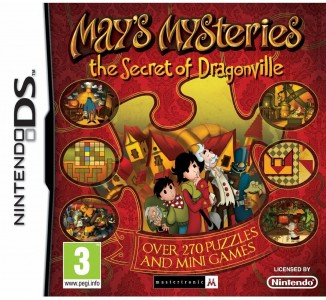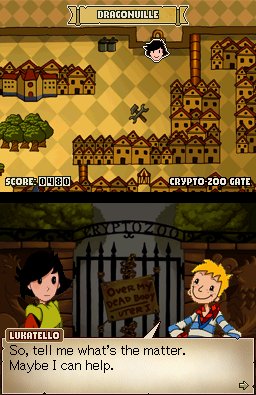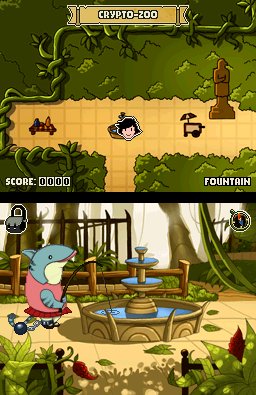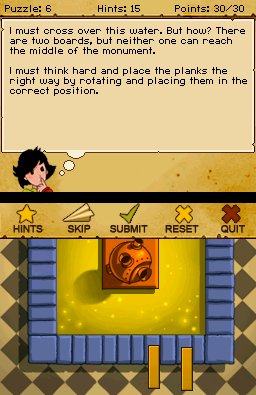
May’s Mysteries: the Secret of Dragonville
Developer: V5 Play
Publisher: Mastertronic
Genre: Puzzle/Adventure
Platform: Nintendo DS
Released: 12th August
They say imitation is the sincerest form of flattery – in which case, the people over at V5 Play clearly have a lot of admiration for Professor Layton’s various mystery-solving outings. From the overall design and layout of puzzles, to the nature of play, to the colour palette and similarly eccentric cast of characters, everything seems to have been influenced by the self-proclaimed puzzle-solver extraordinaire. Even the sound feels oddly familiar, and you’ll be pleased to hear that May’s Mysteries has comparably enchanting, different musical score, even if some sound effects are almost identical.

Your quest starts with a light-hearted hot air balloon ride which turns nasty when you run into a storm, your guide plummets from the basket and you wake up after crash landing in the town of Dragonville to find Tery, your younger brother, missing. The game has 7 minutes’ worth of cut scenes, with this being one of the longer scenes displayed as an animated sequence, (making this particular scene all the more hilarious), including voice acting which brings to life a story which would have otherwise been completely text-based, as all conversations have to be read and aren’t spoken out. Shorter clips are used to capture the atmosphere and introduce you to a new area, whereas the slightly longer ones are used to depict story events.
Playing as May, you soon realise that Dragonville is a strange place; there are no children on the streets, odd encounters with residents keep you on your toes, and running into a ‘Museum of Ballooning Accident Victims’ early on throws up many questions. You soon meet ex-mayor Arthur Doyle, and learn of the current mayor Uter and his evil exploits, with your journey to find your brother turning into a mission to retrieve him. Twists and turns in the plot keep you on edge and questioning what exactly is going on, and the story is compelling enough for you to want to see it out to its conclusion.

The puzzles link in well with the story, with most people having a problem that they need solving before they can let you pass or provide you with the information you need, and some presenting you with their dilemma after they’ve told you what you need, in the hope you will do it as a favour (although still requiring completion before you can move on). There’s still some Layton-esque “this reminds me of a puzzle” nonsense, although most of the enigmas remain relevant, and over the course of the story you will play through around half of 270+ puzzles on offer.
The rest of the puzzles which aren’t integral to the story play their part, too; they are accessible from your backpack at any time (as is a backlog of all story puzzles completed so far should you want to revisit them) and are steadily unlocked as you go along. Completing one of these bonus puzzles earns extra hint points, because much like Professor Layton, each brain-teaser carries two hints to help find the solution, which cost a hint point each. Fortunately, a system has been included to prevent getting completely stuck on a puzzle putting a stop on your progress, as you are also given the option of skipping a puzzle at the cost of 15 hint points. This proves invaluable because while most tasks have logical answers, bringing with them a feeling of satisfaction when you manage to overcome them using your almighty mind, some are overly fiddly and an inconsistent level of difficulty means you could be having trouble on an early stage but breeze through a later stage, or easily complete a simple puzzle only to be completely stumped by the next enigma.

Across your adventure you will meet many different types of puzzle; some involve calculation and logic, whereas some require you to arrange something like piecing together the shards of an object, a sliding puzzle to form a picture, or a picross-inspired hidden picture game. However, not everything about May’s Mysteries: the Secret of Dragonville’s puzzles has been tried and tested by the Layton franchise. It covers some new ground too, in the form of two additions: hidden object searches and rhythm action mini-games. The former won’t be to everyone’s tastes, as the whole idea of searching for a list of objects in a cluttered scene is a fairly mundane task, but as hidden object scenes go, these sections are well presented and adhere to the game’s art-style. The latter, on the other hand, are fantastic, and as well as suiting the game’s musical direction, the rhythm action scenes are great fun to play, making you tap, hold or slide the stylus to the rhythm of the music.
There are a couple of shortcomings in its design, though, namely the fact that despite being entirely touch screen controlled, it doesn’t let you scrawl down any notes or calculations as Professor Layton does; some puzzle that involve drawing a line and physically writing numbers or letters as your answer, but many just involve pressing, and the omission of the option to jot down notes and annotate the puzzle as you work can occasionally hinder your progress as you are forced to retain and consider things purely in your head. Secondly, failing a puzzle can be quite repetitive as you have to skim through the entire conversation again before doing the puzzle. This has probably been done in an attempt to remove any problems with getting back into the game and remembering what you were doing, but it doesn’t fully eliminate the problem anyway, because if you chose to save and stop directly after a puzzle you can have trouble recalling where you need to go next, even if your mission list and the map on the top screen go part of the way to helping you out.

May’s Mysteries: the Secret of Dragonville is one of those rarities: a piece of work that copies another popular creation, but manages to mimic most of the aspects that made the original popular in the first place. It may borrow heavily off of the academic’s antics, but at least it does a good job of it and although some of the new additions and difference don’t work so well, it has ideas and plenty of charm of its own. The story is compelling and brought to life through the cut scenes, exchanges with the quirky characters you meet along the way can be genuinely amusing, and whoever thought to include rhythm action games is a genius as they suit the ambience perfectly. Anyone waiting for Layton’s next adventure could definitely pass the time with this similarly know-it-all puzzle-solver, and could even find themselves a new series worth following.


